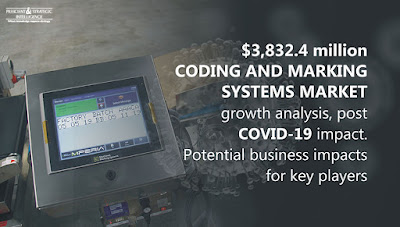How Are Coding and Marking Systems Benefitting Automotive Industry?
The hectic work life of people is compelling them to shift toward packaged foods, dairy products, fruit juices, and bottled water, which is, in turn, adding to the prosperity of the packaged food and beverage industry. This industry is using coding and marking systems to print product price, manufacturing and expiry date, ingredients, and other pertinent details on the packaging of food items and drinks. Thus, the escalating demand for packaged foods and beverages will fuel the adoption of coding and marking systems globally.
Additionally, the increasing need to stop the sale of counterfeit automobile parts will also fuel the coding and marking systems market at a CAGR of 6.4% during the forecast period (2020–2030). According to P&S Intelligence, the market value will rise from $3,832.4 million in 2019 to $7,469.6 million by 2030. The Automotive Aftermarket Suppliers Association (AASA) estimates that the global automobile sector loses approximately $12.0 billion every year because of counterfeit products, such as compression systems, batteries, brake pads, lighting systems, suspension components, and steering linkages.
At present, coding and manufacturing systems are being manufactured by very few companies, such as Dover Corporation, ID Technology LLC, Danaher Corporation, Diagraph Group, Domino Printing Sciences plc, Hitachi Ltd., ATD Ltd., Inkjet Inc., Matthews International Corporation, and Overprint Packaging Ltd. Currently, these manufacturers are introducing a wide range of products to reach out to a greater number of customers. For instance, in October 2019, ATD Ltd. introduced the HC2000 portable coder and the IP2000 online printer, a small-character coder.
Geographically, Asia-Pacific (APAC) accounted for the largest share in the coding and marking systems market in 2019, and it is likely to retain its dominance throughout the forecast period. This can be credited to the surging production of packaged foods and drinks, increasing export of packaged edible items, and toughening government regulations on coding systems. Additionally, the APAC market is also projected to exhibit the fastest growth during the forecasteriod, owing to the swift penetration of piracy and counterfeiting in most of the sectors in the region.
Therefore, the increasing consumption of packaged food items and rising penetration of counterfeit automotive parts are expected to augment the adoption of coding and marking systems.



Comments
Post a Comment